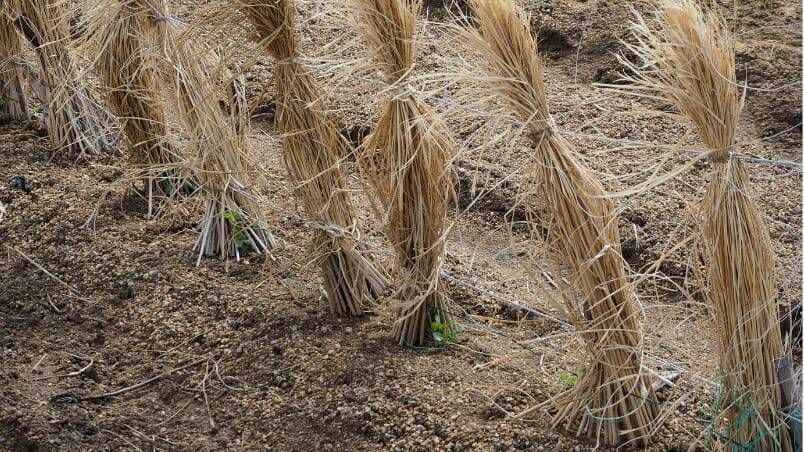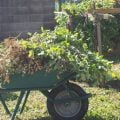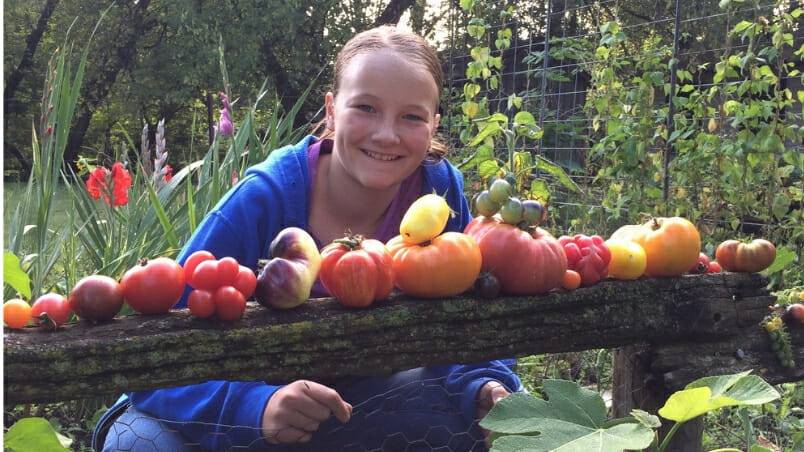I’m hanging up laundry on the balcony on a cold sunny day, when I hear the angry voice down the street. Two men stand beside my garden, one is pointing to my new leaf- mulching box complaining loudly how it touches the cinder block wall that marks his property line. It’s his cinder block wall, he says, and composters attract cats and weasels, and moles and mice and who knows what other forms of life.
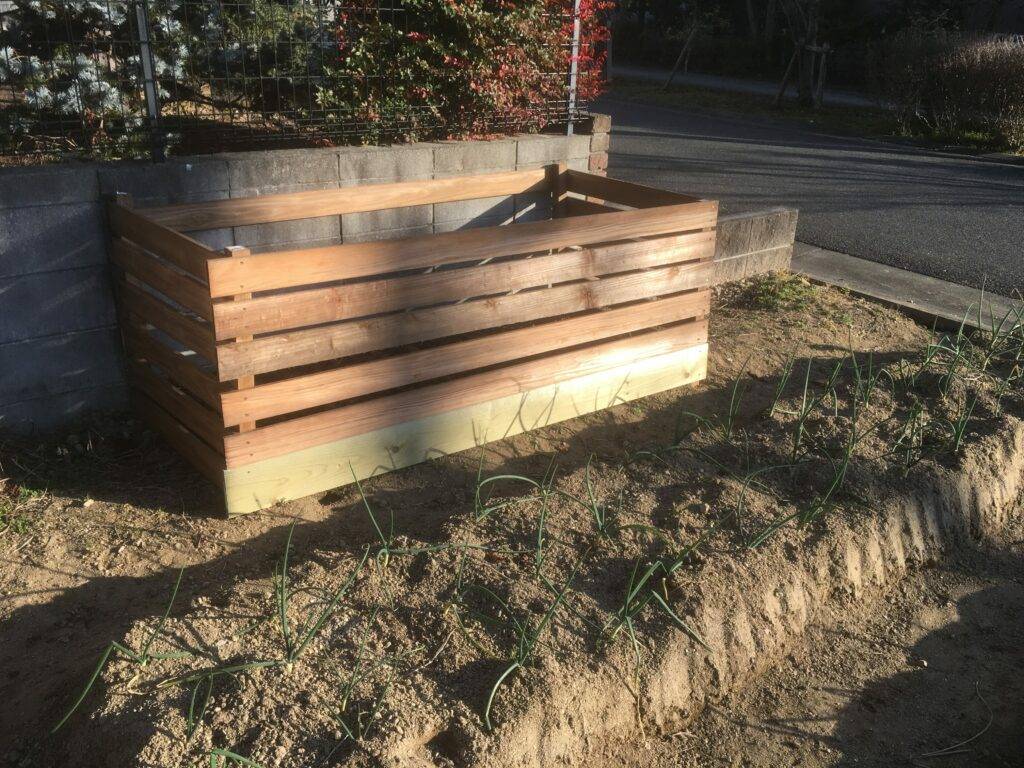
The leaf-mulching box that disturbed the property neighbour
It’s the New Year’s holiday, and I am looking forward to relaxing by my wood stove after a hard December, known in Japan as “the month when teachers run.” However, I know the next week will now be spent moving the piles of soil from my three composting boxes and rebuilding new ones away from property lines. This is a shame as the wall area is shady, rocky and useless for plants, and building the composters in the middle of the garden or by the road takes up good soil and sunny growing space. However, its mending time and must be done.
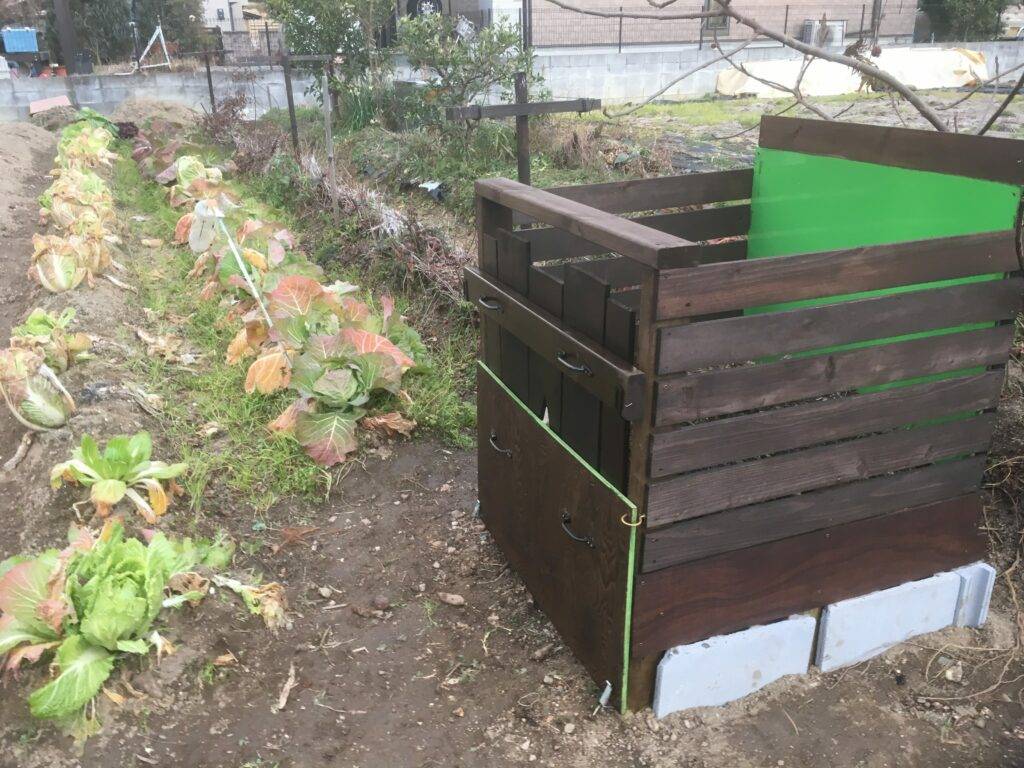
A new compost box, well away from the wall with doors to keep cats out, built in response to a neighbour’s complaints. Old compost heap in background
Other than planting potatoes in February, the period from January to March is the least active period in the garden. It’s a time for fixing up compost boxes, mending fences and relationships with neighbors. One of the down sides of the small home garden is the suburban neighbour who has moved to the small town to enjoy “country life” without the realities of food cultivation. In short, give me the scenery without the smell.
- Gathering ash from the woodstove to put on the fields
- Spreading soil from the old compost on the fields
- Dumping soil from the compost on a row for next May’s planting.
- Spreading ash to add nitrogen to a harvested row.
This is also the time to slowly amend the planting mounds and rows with soil from the composters, ash from the wood fire, and lime bought at the local Do It Yourself store for the big spring planting in April and May.
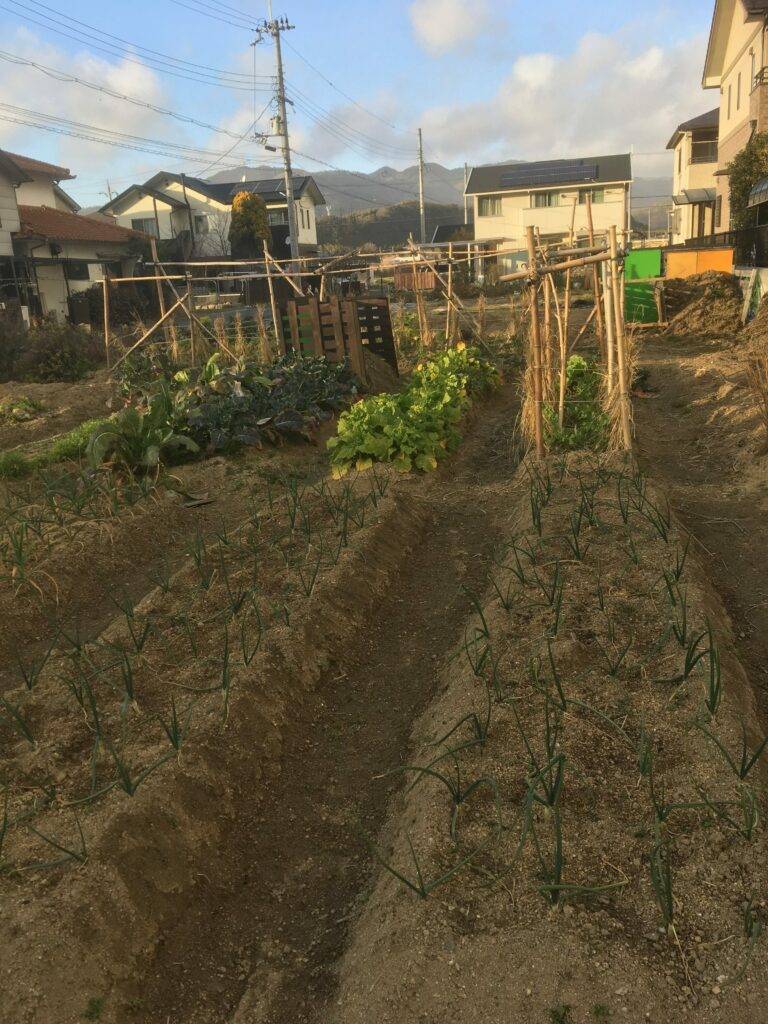
Well weeded rows of onions stand before trellises of snow peas and beans, and rows of nanohana (rape seed) and broccoli.
The Japanese winter garden is far from dormant. It’s full of allium bulbs such as onions and garlic that continue their long, slow, underground growth through the winter to be harvested in May and June; and legumes, such as snow peas, string-beans, and sugar snaps that hibernate in their little wara – traditional rice straw houses – that protect them from frost. Each “teepee” also acts as a trellis for the slowly climbing stalks, their lithe green pods to be picked in late spring.
- Snow peas shelter under wara (rice straw) trellis huts, protected from frosts.
- This year I experimented with mixing crops in my winter rows. It seems to have worked well. Here, daikon, green onions and bok choy co-exist.
- Broccoli
- A cauliflower
The garden is also full of the winter crops that we pick and eat daily, such as, broccoli, kale, bok choy, cauliflower, cabbage, turnips, nanohana or rapeseed flowers, hakusai or Chinese cabbage, leeks, green onions, spinach and that greatest of winter vegetables, Daikon. All of these winter vegetables are planted in September and may be harvested from late fall through March.
- Chinese cabbage tied up against the cold.
- Chinese cabbage eaten by caterpillar, whose black excreations dot the leaves.
- Pale green inner leaves contrasted against the dark green outer leaves.
In wintertime, the temperature here hovers between 0 and 15 degrees Celsius, so there is little need to worry about freezing or severe frost damage. Tying up the outer leaves of Hakusai is protection enough against the cold. It also keeps the sunlight out, preventing the inner leaves from turning green and losing their pale color and delicate flavor, as photosynthesis smashes the chlorophyll molecules, bringing out the bitter magnesium in the cabbage. Tidying the cabbages, I also check for the telltale tiny, black, sticky pellets or mushy yellowish slime of insect excretions before tying up the outer leaves, as these, nearly-impossible-to-see, light green caterpillars and pale slugs like to hibernate in this leafy home. They crawl into the curled green heart of the plant, crawl up the leaves, and devour it from the inside out. I have to carefully pull back the outer leaves, and then search. If there is poop but I cannot see the bug, a quick tapping on the plant causes the caterpillars to curl up and drop into the folds at the base, where they are easier to see and kill.
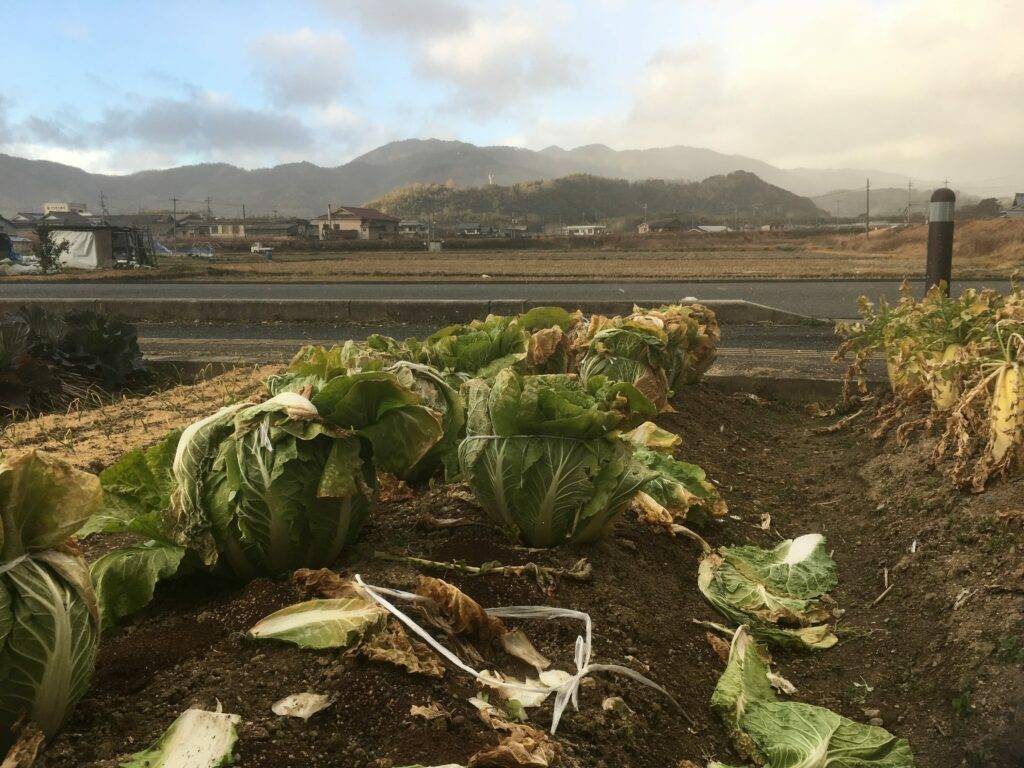
Chinese cabbage and daikon weather a light January Snow.
Most herbs also survive and provide throughout the year. In a warm winter such as the one Japan is going through now, even lettuce and the spiky leafed mizuna – so wonderful in salads – are edible until early January. In colder winters, spinach may remain stunted until the spring and then resume growth, so, all these vegetables are simply left in the ground, and plucked as needed. In short, the winter garden acts as an enormous, natural refrigerator. This is lucky, as Japanese houses – famous for a lack of space – do not have basements, possibly due to it being an earthquake country, or more likely to a lack of necessity since the earth does not freeze at this latitude and water mains are safe. This means no cold storage, and no place for a second fridge or freezer.
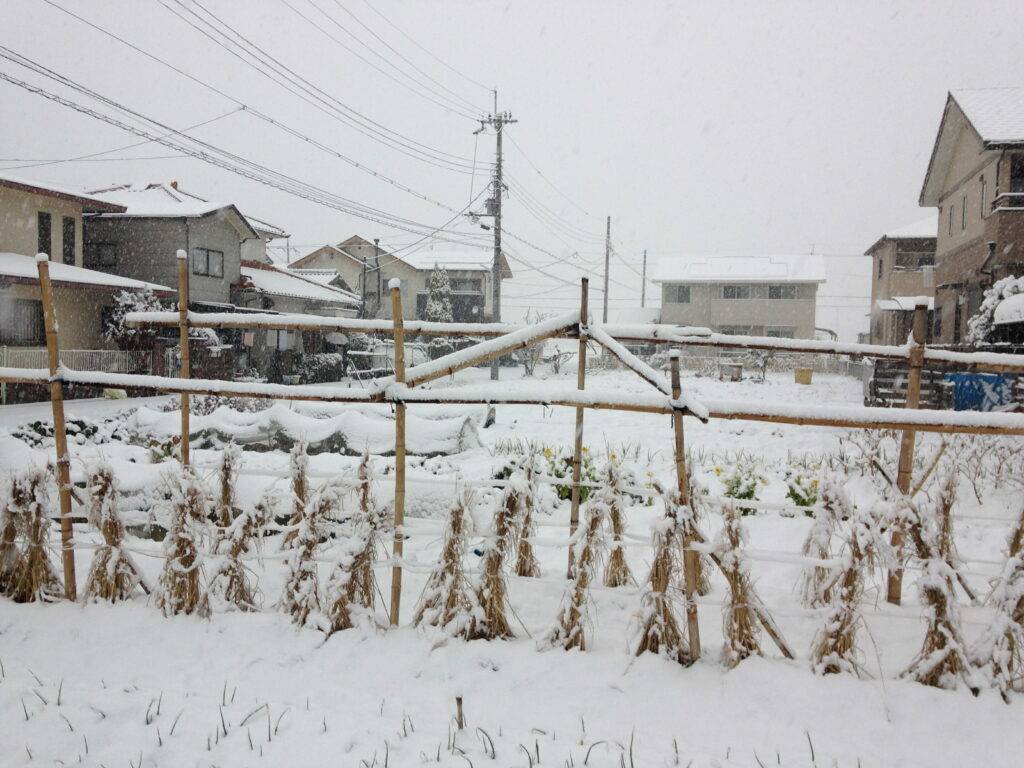
A rare heavy snow blankets the winter crops.
The small vegetable garden must also make way for more crops, so what happens to those vegetables that cannot be left in the ground? Potatoes, also planted in September, are harvested in December, and stored outside in a well-ventilated box. I keep them on the north side of the house in a storage cupboard so they receive no sunlight. The ventilation holes are covered with a fine mesh to keep bugs out. Even the potatoes planted in February survive fine here after being harvested in the hot summer.
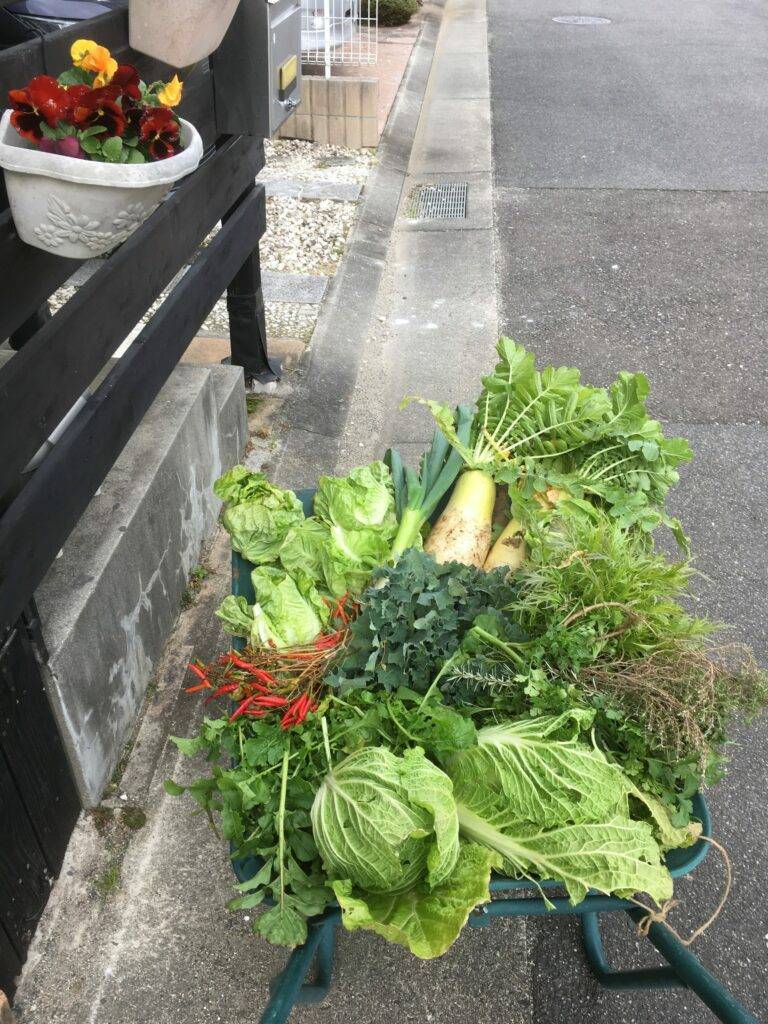
A New Year’s Harvest: Boston lettuce, green onions, coriander, kale, daikon, cabbage, hot red peppers and rosemary.
Sweet potatoes however, I learned the hard way, do not store well in cold. In my first year, I automatically stored them with the other potatoes, and they went rotten within a week. I finally asked a farmer, who told me the cold activates their natural sugars which start the process of decomposition – what they need is warmth. This is just one of hundreds of examples of being able to easily benefit from the knowledge of an older farmer in my community. Now, I wrap my sweet potatoes in newspaper before placing them in boxes, and then stack the boxes beside the woodstove in the living room. They also last the entire year, and we have sweet potatoes baked, fried, and in soups or loafs until next fall’s harvest.
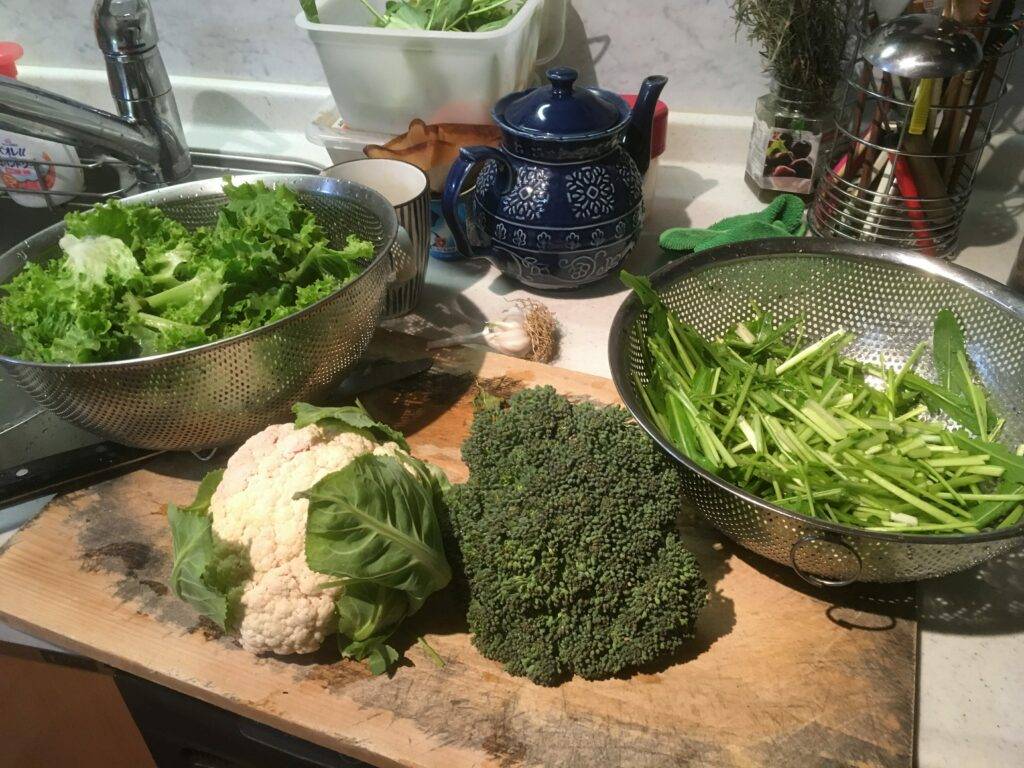
Getting dinner ready with winter veggies.
Onions and garlic, also planted in the fall – late October and September respectively and harvested in May and June – are simply gathered in bunches of four or five, tied together with string and hung up to dry under a shed roof or eaves. We hang ours under the balcony, and often when cooking, I just have to reach out the sliding glass door, and grab what I need. While most last the whole year, onions do tend to turn black and rot as the year goes on. The black mold seems to start on the outside, and is easily removed, leaving the inner onion fine and tasty. This may be due to my balcony being on the south side with a transparent roof. However, two years ago some blight took most the onions in the area, and I lost half my crop in a matter of weeks. Many other farmers said the same; our onions rotted from the inside and turned into a dripping, stinky liquid. So I look forward to being able to afford building a proper large shed with wide eaves on the north side to keep them a little distance from the house, because every year, a few succumb to this rot, and I’d like to avoid both the phenomenon and the smell…just like my fussy neighbour!
- Freshly dug potatoes dry out amongst the winter vegetables before being put into outdoor storage.
- Outdoor storage
Speaking of noxious odours, with the compost boxes rebuilt to appease my neighbours, I can finally relax a bit and do some writing and recharging. February to March is spring break for university teachers, a time when I can repair both my body and mind with a good book by the fire. The garden and I need to mend and gather energy for the coming spring, especially April when classes and planting season begin again.

Three boxes of newspapers wrapped sweet potatoes stand near the wood stove in the living room to keep warm and prevent rotting.
- Onions gathered for storage.
- Onions stored beneath the balcony roof
- Onions stored beneath the eaves.
- Garlic stored in the shed.
- Garlic hung beneath the balcony
- Garlic stored in the shed

My dog Beatle relaxing by stove
Keith is an environmentalist, university lecturer, musician, author, and organic farmer. His Master’s thesis on Roman Agriculture in North Africa, is from Concordia University, where he taught Roman history and Greek mythology, as well as writing and study skills. For over two decades, Keith has lived in Japan where he teaches academic writing, debate and social studies at three universities; plays three times a month with his band, Roman Rhodes and the Born Again Pagans; and of course, gardens. He is currently working on a book about farming in Japan, focusing on its traditional methods’ benefits to the environment and the absolute necessity of the small farm to our survival.

